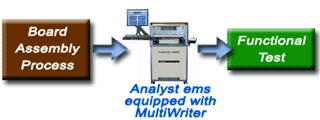Part Programming at ICT
MultiWriter On-Board Gang Part Programming
Programming CPLD (Complex Programmable Logic Device) parts such as microcontrollers, serial Flash and FPGAs after they are attached to the circuit board [’on-board programming’] simplifies the manufacturing process and reduces inventory and rework costs compared to mounting pre-programmed chips.
Since the contents of Phase Change Memory (also known as PCM, PCME, PRAM, PCRAM, and C-RAM) can be lost because of the high temperatures needed to solder the device to a board, on-board programming is required.
Simultaneous Part Programming
MultiWriter uses patented simultaneous programming technology to simultaneously program up 384 chips at one time, up to 16 different types — usually in seconds instead of the minutes required by conventional programmers.
MultiWriter technology has already programmed millions of parts on millions of boards. Its ability to program up to 384 chips at once makes MultiWriter the industry’s most productive on-board part programmer.
MultiWriter Multiplies Productivity Two Ways
MultiWriter technology is available on CheckSum Analyst low cost in circuit testers or in the new standalone MultiWriter pps™ on-board gang programming system where at least four parts need to be programmed on a board or multi-board panel.

Combine in circuit test and MultiWriter part programming in a single system.
MultiWriter installed in an Analyst series in circuit tester:
- Simultaneous programming ability means faster programming times, which means faster throughput
- Eliminates expensive channel cards required by traditional in circuit solutions
- No costly retrofit required to ICT system for hardware/software specific to part programming applications

The standalone MultiWriter pps gang programming system programs boards and panels with multiple parts much faster than on a traditional in circuit or functional tester.
MultiWriter pps used following the traditional in circuit tester:
- High signal integrity via short wire lengths is well-suited to today’s higher programming speeds
- Unified hardware architecture eliminates problems with multi-vendor dongle-type solutions
- Simultaneous Programming means faster programming times; part programming will not become a process bottleneck.
MultiWriter Features & Benefits
MultiWriter technology is a clean, low cost solution to increase part programming productivity–regardless of whether it’s in an Analyst in circuit tester or in the MultiWriter pps gang programming system.
- Innovative, patented technology to gang program serial flash and embedded flash devices mounted on the board or multi-up panel at near-data book speeds.
- Data Encryption Protection option insures your IP (Intellectual Property) is not at risk anywhere in the world.
- Unique data (e.g. serial number, date code, MAC address, calibration data, etc) can be written to individual chips, as they are being gang-programmed.
- High throughput via simultaneous programming and verification of one to 384 chips¹ at a time.
- Low cost via “universal hardware” that eliminates costly channel cards used by in circuit testers and easily configured software.
- High signal quality with controller and programming buffers mounted right in the fixture.
- Comprehensive serial flash and microcontroller library
MultiWriter is the first ISP programming system integrated right into the bed-of-nails fixture
- Fixture-based architecture delivers maximum flexibility at the lowest possible cost.
- Eliminates the requirement for expensive tester channels and long signal paths.
- Smart ISP™ ensures that chips on failed boards are not programmed — even when they are part of a „multi-up” panel. With CheckSum’s Smart ISP technology, there’s no possibility of damaging expensive components. Power is applied only to those boards within a multi-board panel assembly that have passed the ICT opens/shorts and other component tests.
Simultaneous device programming
- Up to 384 ISP devices whether on a single board or distributed across multiple boards in a panel assembly — and all combinations in between — are programmed simultaneously.
- Flexible code verification: can be performed after all programming is complete or on a step-by-step basis.
- Boards need not be de-paneled prior to programming parts.
Comprehensive device and bus algorithm library
- Supported bus algorithms include I2C, SPI, Microwire, JTAG, and PIC.
- MultiWriter’s library supports user-defined algorithms, as well.
Unique data may be programmed on a per-device basis — even on panelized boards
- MultiWriter handles data unique to each device such as serial number or board calibration information.
- Data collected on-the-fly at earlier test stages may be manipulated (i.e., calculations performed) and then programmed directly into the device during the same test sequence.
Fixture-mounted buffer boards ensure the highest signal quality
- A buffer board associated with each device to be programmed delivers clean signals and state conditioning at the highest possible programming speed.
- Buffer boards are mounted right in the fixture, eliminating cabling problems and ground return issues for noise-minimized reliability.
- Up to 16 MultiWriter control modules with up to 24 buffer modules each for 384 maximum devices. One MultiWriter control module required for each different device family.
¹ Up to 16 MultiWriter control modules with up to 24 buffer modules each for 384 maximum devices. One MultiWriter control module required for each different device type.
† MultiWriter Technology is protected under U.S. Patent No. 7,802,021.

